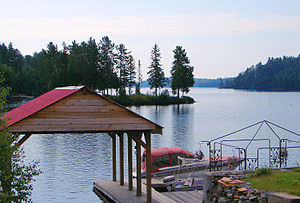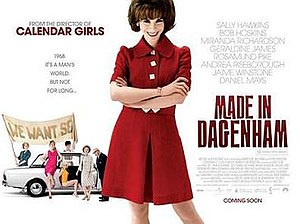 Image via Wikipedia
Image via WikipediaI saw a Croatian film last night that dealt in subjects that should be familiar to Canadians, including the agonies of people who become members of diasporas of whatever country, and of the problems of families that are divided by emigration. The name of the film was Kotlovina, a reference to some local dish that was being prepared for a monster family gathering when three sisters who had not seen each other for 35 years finally managed to get together. The director was Tomislav Radic.
This film only last week won the grand prize at the Pula film festival. Radic is a former head of production of Croatian TV, and in 2005 he made a widely praised film called What Iva Recorded, about a 14 year-old girl who was given a present of a video camera with which she began to record her family.
That probably gives a clue to Radic’s interests --- family dramas --- and this film was entirely about the whole family, the sisters, their husbands, their children, their neighbours, as they all set up for the party.
My knowledge of Yugoslav film is sketchy. I remember well the remarkable film W.R.: The Mysteries of the Organism, made in 1971 by the experimental Yugoslav director Dusan Makavejev, which purported to be an examination of the work of William Reich, but actually was an examination of the role of sex in a Communist country. The film was a great success in the Western world,it came like a breath of fresh air, but it was banned in Yugoslavia and earned Makavejev exile from his home country.
During his exile he made a scandalous film called Sweet Movie, so sexually explicit that the Canadian actress Carole Laure quit it before it was finished in disgust at some of the actions called for by her character (she was making love on the Eiffel Tower when she was interrupted by a group of nuns, for example) and Laure’s resignation from the film prompted the director to shoot an entirely different sequence around a different actress. Later, Makevejev made a film in Australia called The Coca Cola Kid, starring the remarkable American actor Eric Roberts (brother to Julia), so it seems that the diaspora has never been far from the thoughts of Yugoslav directors.
I found the opening sequences of Kotlovina to be almost tiresomely slow, although they did succeed in delineating the characters. Two of the sisters were traveling by car to the home of the third, in these earlier sequences, and on the way the one sister, a 40-ish widow, who had returned from Australia, where she had been taken as a child of four, got involved in a sexual romp with the stepson of one of her sisters, a virile 20-year-old lad. During the course of her liaison she was bitten by some insect, and her bite required treatment. She had also lost her panties, which her sister found later in the young man’s overcoat. This led to a huge confrontation after the Australian returned from a visit to the hospital for a shot of anti-rabies vaccine.
The film ended with a really remarkable sequence of the family party, as all the participants became drunk, and started yelling at each other. A visitor (daughter of the woman doctor, who was invited to the feast, thus establishing the neighborliness of Croatians), began to yell her detestation of the diaspora, populated, as she claimed, by a group of people whose only objective in leaving their home country was to have a swimming pool. Finally, the visitor in her turn burst out her resentments with her unsatisfactory life in Australia: she had had no pool, she complained, all she had was a marriage to an older man who didn’t love her any more than she loved him.
The party almost broke up over these quarrels, and would have done if the doctor’s daughter had not flaked out entirely, having drunk far too much. Seeing to her, getting her home, occupied everybody’s attention, taking their minds off their quarrelling, and the film ended with the three sisters clutching each other affectionately, and laughing gently at their ridiculous quarrelling.
I don’t think this film is destined to do particularly well abroad. I can understand if it becomes a success in Croatia, but its slow beginning will prevent it from capturing the attention of foreign audiences.
What was interesting was to find a movie that dealt with such important subjects in such an intense, concentrated manner. After all, in a world rent with emigration, much of it designed simply to improve the conditions and standards of living of the emigrants, these resentments are bound to become more intense as time goes on.
I felt I could relate to it myself. I lived in Canada for 26 years before becoming a citizen, and for all of that time I never considered myself truly Canadian, although I felt I was qualified because I was performing work that was essential to the quality of Canadian life. At least I thought so.
After returning briefly to New Zealand, my home country, I realized I didn’t belong there, either. I could have complained, as the protagonist in this movie did, that I was neither one thing nor the other, neither a Kiwi nor a Canuck. But I figured I had been operating according to an outmoded set of beliefs about one’s personal roots. Your roots, I discovered are created by your friendships, acquaintances, working life, your beliefs and actions, the whole corpus of your life, not from some phony attachment to a particular place.
The Australian protagonist in this film announced her intention of going back to Australia. How many emigrants have done exactly this: gone home, discovered it is no longer your home, and returned to their new home, more contented for the experience.















